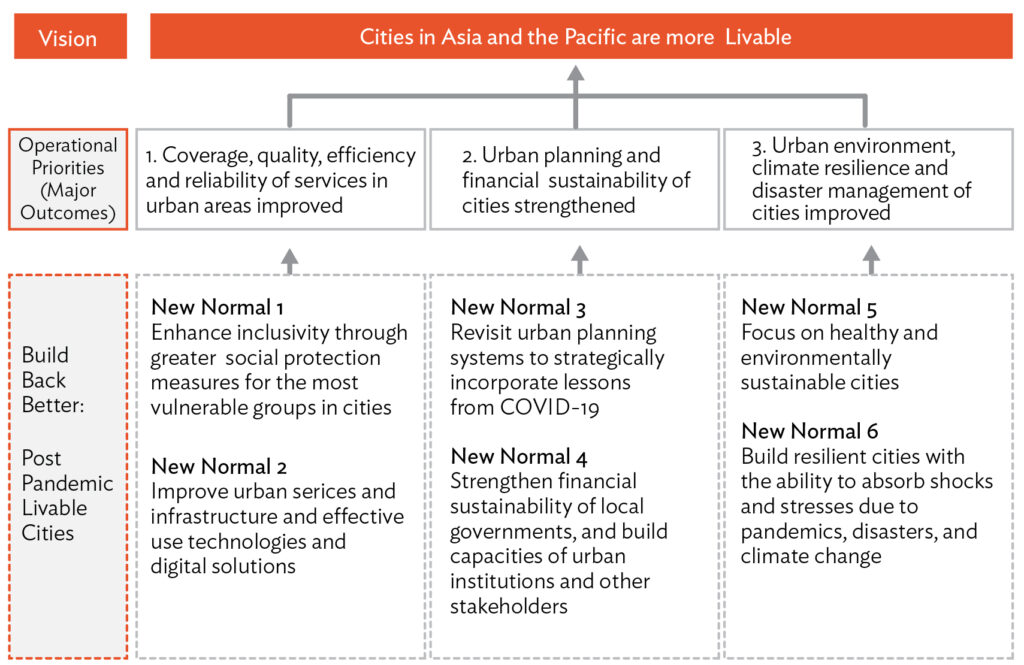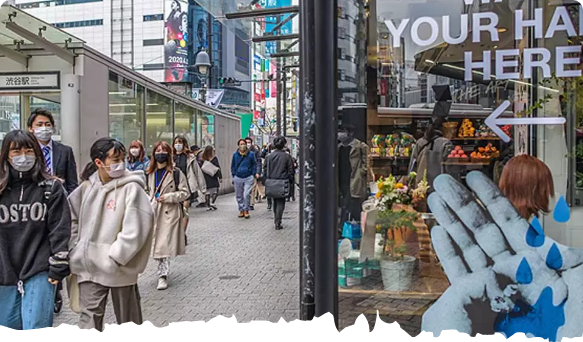Introduction
Cities with high density face a potential high risk of exposure to the coronavirus disease (COVID-19). The virus is easily spread by people through direct and indirect contact, especially in areas where social distancing is barely possible.
The COVID-19 pandemic is exposing glaring gaps in urban planning and development, especially for low-income and vulnerable neighborhoods where substandard housing and informal settlement are densely located with poor physical infrastructure and unequal access to core services. Not to discount the human toll and tragedy of the pandemic, but this crisis can be turned into an opportunity and momentum to reduce inequalities of access and make cities more safe, healthy, environmentally sustainable, resilient, and inclusive.
This article is adapted from a guidance note issued by the Asian Development Bank to help cities in Asia and the Pacific to effectively respond to the crisis and to “build back better” in the immediate term as well as short- and medium-term while continuously adapting to a “new normal.”
Challenges
Rapid economic growth and urbanization have created megacities in the region and fostered urban sprawl in surrounding areas. Yet, many cities have not been able to keep up with the growing needs of their population. They now face challenges that have been further aggravated by COVID-19. These include inadequate urban and social infrastructure, intensified impacts on vulnerable population, ineffective information and communication technology (ICT) system, urban economic crisis at the macro and micro levels, and strained local government and planning.
The urban poor are the most adversely affected by this pandemic. Often living in overcrowded, unsafe, and unhealthy environments with poor access to water, sanitation, and other basic services, they face increased vulnerabilities to the disease. They also have reduced income and livelihood opportunities because of mobility restrictions, furloughs, and the slowdown in economic activities.
Considering the inadequate social protection systems, supporting vulnerable people and enterprises in cities is a challenge. The existing political, economic, and regulatory systems in developing economies often limit cities’ systemic and holistic response to workers and small businesses and to revitalize economies.
Key Approaches
Most cities are currently focusing their resources on the immediate management and response to COVID-19. While this is critical, cities paying attention to how immediate actions align with the short- and medium-term measures will gain an advantage toward building back better. It will also be useful to understand how short and medium-term actions synergize with other ongoing or planned investments and broader agendas.
Key approaches for livable cities in the immediate term are the following:
- remodel public spaces, commercial, office, industrial buildings, and civic institutions to adapt to COVID-19;
- ensure continued smooth operations of urban water and wastewater utilities; provide essential water, sanitation, and hygiene (WASH) services; and address environmental problems of increased solid waste and medical waste management;
- address the special needs of informal settlements and vulnerable people;
- address the changing travel needs of the residents during COVID-19; and
- effectively use ICT and digital solutions.
These are in line with the vision and three major outcomes of ADB’s Strategy 2030 Operational Plan for Priority 4: Making Cities More Livable (Figure 1).
Figure 1: Making Cities More Livable: Post-COVID-19 Emergency Response and Immediate Actions


These immediate actions are also part of the short- and medium-term efforts to:
- enhance inclusivity through greater social protection measures for the most vulnerable groups;
- improve urban services and infrastructure and effectively use technologies and digital solutions;
- revisit urban planning to strategically incorporate lessons from COVID-19;
- strengthen financial sustainability of local governments, and build capacities of urban institutions and other stakeholders;
- focus on healthy and environmentally sustainable cities; and
- build resilient cities with the ability to absorb shocks and stresses due to pandemics, disasters, and climate change.
These are in line with the vision and three major outcomes of ADB’s Strategy 2030 Operational Plan for Priority 4: Making Cities More Livable (Figure 2).
Figure 2: Making Cities More Livable: Post-COVID-19 Short-and Medium-Term Actions for the New Normal


ADB’s Livable Cities Projects
With the aim of addressing the impacts of COVID-19, ADB’s livable cities projects will be designed to support cities to be more healthy, inclusive, and resilient while supporting local economic development and creation of well-paying jobs for the citizens.
Specifically, projects will include components to support, among others, (i) integrated urban planning process and coordination across departments and local administrative boundaries to strategically incorporate lessons from COVID-19 for safe and healthy cities; (ii) greater social protection measures for the most vulnerable groups, including affordable housing with integrated urban services in cities; and (iii) improvement of urban environments, including more focus on uninterrupted utility operations, WASH, wastewater and fecal sludge management, and solid waste and medical waste management.
The livable cities projects will also include greater focus on strengthening financial sustainability, supporting financial inclusion, use of technologies and digital solutions for improving urban services, and building capacities of stakeholders, including communities.


